Uncategorized
All Day Bach Organ Marathon in New York
WQXR Radio is sponsoring an all-day Bach Organ Marathon beginning at 7am on Saturday, November 22nd, at St. Peter’s Church in Manhattan. The marathon is curated by Paul Jacobs, chair of the organ department at the Juilliard School. Ticket prices range from $10 to $75 for the entire marathon. Performers include:
7:00 AM: David Crean
8:15 AM: James Wetzel
9:30 AM: Raymond Nagem
10:45 AM: Yinying Luo, Colin MacKnight, Janet Yieh
12:00 PM: Chelsea Chen
1:15 PM: Ryan Jackson
2:30 PM: Benjamin Sheen
4:15 PM: David Ball, Daniel Ficarri, Griffin McMahon
5:30 PM: Isabelle Demers
6:45 PM: David Enlow
8:00 PM: Paul Jacobs
9:15 PM: Christopher Houlihan
10:30 PM: Michael Hey
11:45 PM: Ryan Kennedy, Alexander Pattavina, Gregory Zelek
Additional information, including a live stream, is available on the WQXR website
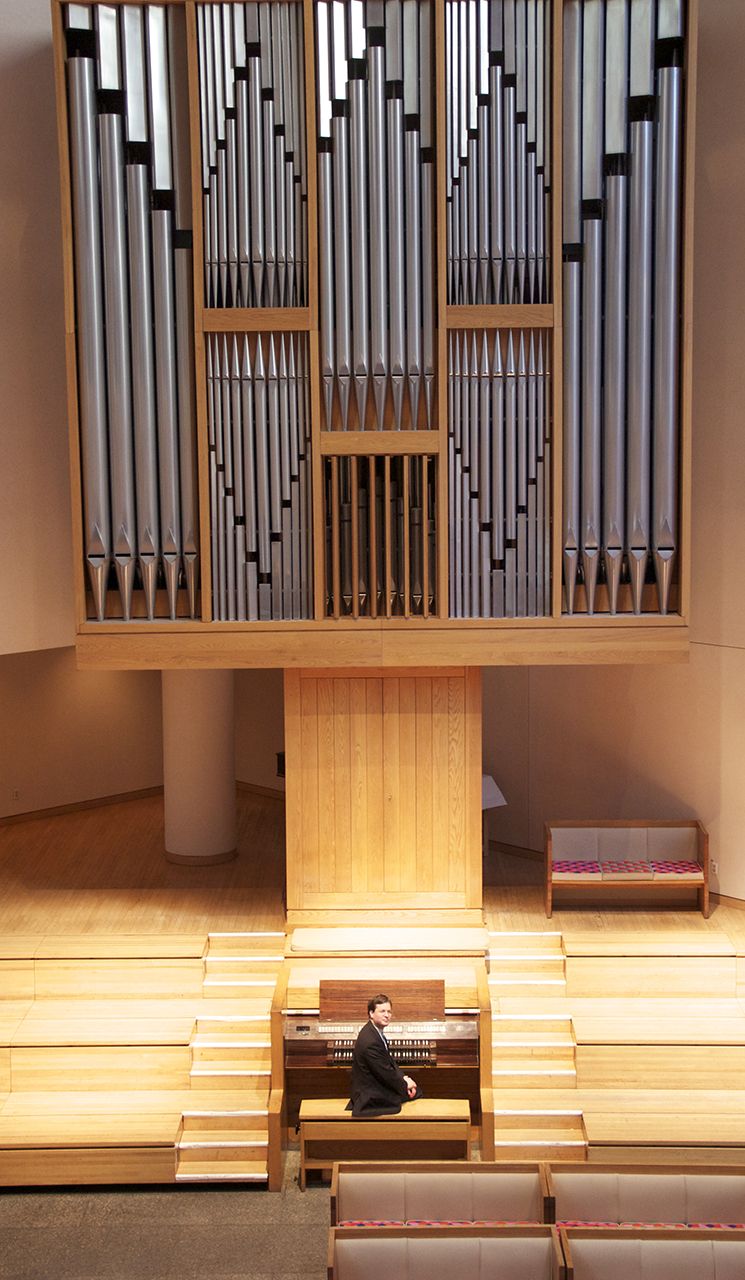
Paul Jacobs at the St. Peter’s Church organ.
Photo credit: Kim Nowacki/WQXR
November 2014 TAO Features Schoenstein & Company Organ
The November, 2014 issue of TAO features the installation of the Lewnosksi Family Organ in Dahlgren Chapel at Georgetown University, Washington, D.C. The organ was built by Schoenstein & Co. from San Francisco, CA.
It began on a snowy day:
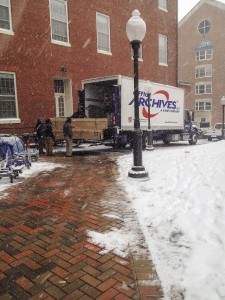
Pipework of the Great Diapason chorus (L) and Pedal 16′ Open Wood pipes, horizontal, behind central wall (R):
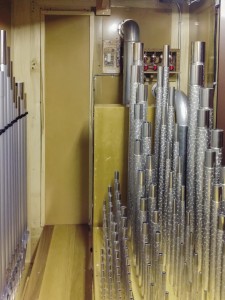
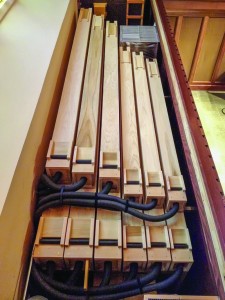
The casework is installed:
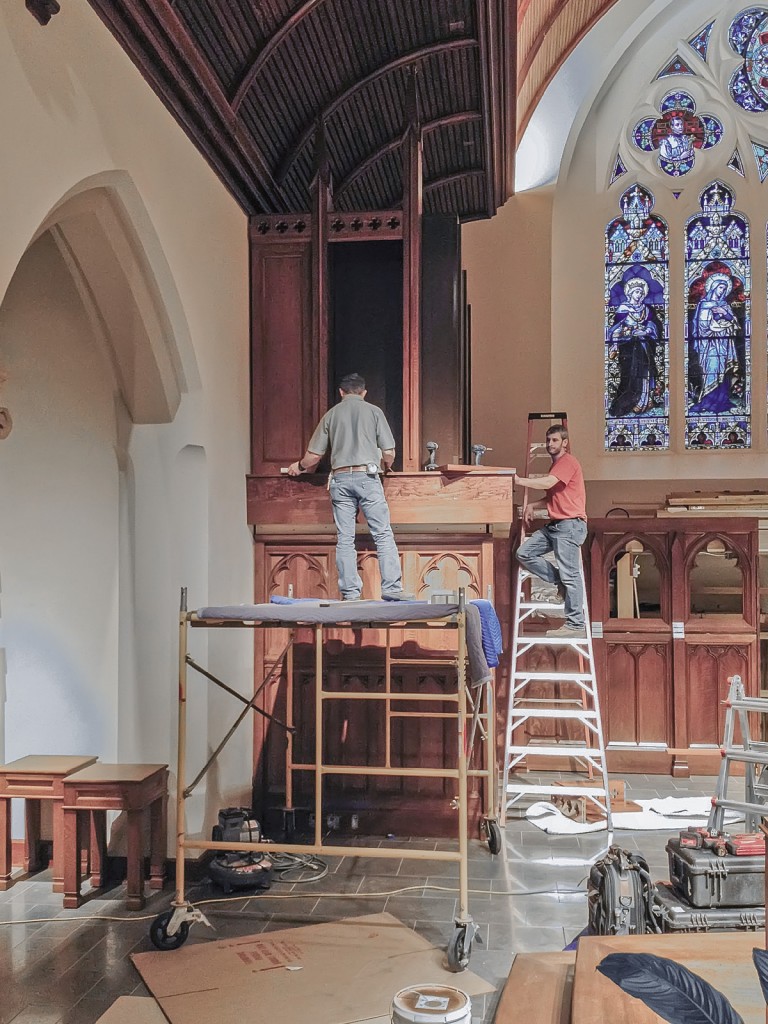
Read the article and view the complete stoplist in the November issue of the The American Organist.
Pogorzelski-Yankee Composition Competition Deadline Nears
Submissions to the 2016 Pogorzelski-Yankee Composition Competition are due by November 28th, 2014.
The Pogorzelski-Yankee tracker organ is now in its new home at Indiana University of Pennsylvania. The competition fosters the creation of new music for this instrument and organs of this size.
The 2016 Competition calls for an organ composition of 10-12 minutes in length; there are no restrictions in regard to compositional style. The competition is open to proposals from composers of all ages and nationalities.
For further information:
Pogorzelski-Yankee tracker organ installation
New Music & Competitions
AGO Great Lakes 2015 Regional Convention Features Thirteen Venues & Organs
Thirteen different venues in Indianapolis and Bloomington Indiana will host performances this summer at the AGO’s Great Lakes Regional Convention. The venues are:
Indianapolis
Christ Church Cathedral
Christian Theological Seminary
Grand Hall, Indiana Landmarks Center
St. Luke’s United Methodist Church
Second Presbyterian Church
St. Paul’s Episcopal Church
Warren Performing Arts Center
All Saints Episcopal Church
Christ Church Cathedral
St. John the Evangelist Catholic Church
Trinity Episcopal Church
Bloomington
Auer Hall, Simon Music Center
Alumni Hall, Memorial Union
For more information:
Links to all 2015 AGO Regional Conventions
The organs and venues featured in the home page slider are:
LEFT: Christian Theological Seminary (Indianapolis) – Holtkamp Opus 1999 (1987), III/34. Pipe Organ Database Entry
CENTER: Grand Hall, Indiana Landmarks Center (Indianapolis) – Thomas P. Sanborn & Son (1892), II/33. Pipe Organ Database Entry
RIGHT: Auer Hall, Simon Music Center, Bloomington, IN – Instrument: C. B. Fisk Opus 135 (2010), III/68. Pipe Organ Database Entry
November 2014 TAO Feature Article
Dahlgren Chapel, Georgetown University, Washington, DC
Schoenstein & Co., San Francisco, CA

In the heart of Georgetown University in Washington, D.C., stands Dahlgren Chapel of the Sacred Heart, built in 1893 and the gift of Sarah Dahlgren, whose husband was Admiral John Dahlgren. The Jesuit religious community that founded the university takes great pride in this chapel, which is the spiritual gathering place for Roman Catholic liturgies on the campus. In 2011, a renovation was launched to reinforce the chapel’s structural foundation and to preserve and enhance both its interior and exterior. The blessing of the renovated chapel took place in April 2014.
I was pleased to serve as consultant in this project, assisting the university in reviewing proposals from several organbuilders for a new instrument for the chapel and helping to determine the characteristics of the organ that would best suit its needs. I also helped the community understand the language of the organ and engaged them in planning for and welcoming its arrival.
Schoenstein & Co. was chosen to build the instrument, and Dahlgren Chapel is now home to the new Lewnowski Family Organ with 19 ranks, three manuals, and double expression on some stops of the Swell division. The inaugural recital program that I will play on November 7, 2014, is designed to feature all the colors of this versatile instrument. The organ meets the needs of liturgy and concert, and is scaled to produce a balanced tone that fills the room. An instru- ment such as this, located at the center of the university campus, attracts the attention of students, faculty, alumni, visitors, and the local community. Their fascination with the visual and aural aspects of the organ leads to appreciation of this prominent artistic element of the chapel. It is the fusion of pastoral and academic disciplines that provides excel- lent ground for the appreciation of the instrument in this setting.
Once the organ installation was complete, I took the opportunity to converse with the chapel music director, a university student, the vice president for mission and ministry, and the organ-builder. Here are some of their thoughts.
Lynn Trapp
James Wickman is director of music, liturgy, and Catholic life, in the Office of Campus Ministry.
LT: Georgetown University does not offer a music degree, though there is an active choir program, including the chapel choir, under your direction. How might the organ serve as an instrument of formation for students participating in music at the university?
JW: In general, the organ is an instrument for the celebration of the liturgy. Because of the high quality of the instrument and the commitment by the University to fund and install such an instrument, the students are shown by example that the liturgy has a central role in the life of such a large and important organization as Georgetown University. Also, the new organ serves a purpose for students who are interested in providing music in the liturgy. I have already seen a rise in interest in playing the organ; we have two student organists,and others have expressed interest—and we have just barely begun to use the instrument! These are not students who are getting degrees in sacred music or organ, but students from all parts of the university who are interested in expressing their faith through music. An instrument like this attracts them in a new and exciting way, and will open that door even wider.
LT: Describe the types of music the organ serves in the chapel.
JW: The new Schoenstein organ is the anchor of our liturgical music program. It is used for Sunday night Masses that students attend—to lead liturgical music and accompany the University Chapel Choir—and at special services throughout the year. In addition, this instrument will expand the resources and opportunities of the university’s choral program. Performances inside the chapel are limited to sacred music, so some of Georgetown’s choirs are now turning to sacred literature so they can use the organ as part of their repertoire.
LT: How is the organ serving as ensemble instrument with choir, piano, guitar, obbligato instruments?

JW: This is an area of great growth and potential that we are just beginning to explore. I think the instrument has strong possibilities for many combinations of instruments with all of our liturgical choirs. The combination of guitar and organ, or using the pedals only with the piano and other ensemble instruments, or playing obbligato parts when one of the instruments is not available . . . there are many possibilities.
LT: What specific opportunities does the organ offer for orchestration in the liturgy?
JW: Both manuals are under expression, and four stops of the Swell are in an additional swell box. It is extremely flexible for an instrument of its size. The Cymbelstern and the digital Harp and Chimes also enhance the instrument. I anticipate a rise in the quality of our performance repertoire in general, in sacred music concerts, choir anthems, prayers services, and recitals. This instrument offers an expansion into new repertoire that is exciting for me and for the students. It will inspire them to reach higher musically and prayerfully!
Stephen Gliatto is a student in the chapel choir
LT: What does this organ bring to the music making of the chapel?
SG: The location of the instrument behind the sanctuary altar, where the choir and instrumentalists gather, heightens the leadership of music ministry. The pipework surrounds the choir area and provides for clean and rich accompaniment.
LT: Have you observed interest by other students in this instrument?
SG: Students here seem very interested in the organ. The renova- tion period was followed very closely by the faith community at Dahlgren Chapel, and the installation of the new organ was greet- ed with enthusiasm. Most telling are the positive reactions from alumni who have not visited Georgetown for some time. They de- scribe the chapel and organ as stunning, breathtaking, and amaz- ing, and see it as a wonderful new asset to the faith community.
LT: What knowledge did you have about the pipe organ before experiencing the Schoenstein organ, and what about this instrument have you found most notable?
SG: I knew nothing about the design or construction of a pipe organ before this project. By far, the most noticeable feature for me is the presence of its sound. When I was first directing the choir from the podium, the effect of organ and choir together was tremendous—like I was being washed away in a cohesive sea of music, in which I could feel and harness the power of God.
The Rev. Kevin F. O’Brien, SJ, is Vice President for Mission and Ministry.
LT: How does the addition of the Schoenstein organ contri- bute to the liturgical life of the campus community?


KO: The organ resounds beautifully in the worship space. The many different types of communal services that take place in the chapel throughout the liturgical year will benefit from the sound of the organ, and congregational song will be fortified.
LT: Describe the overall approach to the renovation of the chapel, and the organ’s role in blending with the visual and aural aspects of the project.
KO: We wanted to maintain the chapel’s familiar appearance, yet re- fresh many of its worn features. The chapel is a warm and welcoming sa- cred space, and we wanted to main- tain that hospitable atmosphere. A central feature of the chapel is the stained-glass window behind the al- tar, beautifully depicting the devo- tion to the Sacred Heart (thus the name of the chapel). It was impor- tant that the casework did not de- tract from the breathtaking visual of the vibrant window. The organ was constructed to both blend into the architectural features of the chapel— especially the vaulted roof—and also highlight the centrality of the win- dow. It is as if the organ has always been there.
LT: What has been the response of the campus clergy regarding this instrument?
KO: The organ has been well received. The former organ in the space was in the rear of the nave, and Jesuits applauded the place- ment of the new organ at the front of the chapel. Presiders for liturgy have expressed appreciation for how the organ sounds in the space.
Jack Bethards is president of Schoenstein & Co.
LT: What is unique about the tonal design and versatility of this organ?
JB: First, with exception of the principal chorus, we have avoid- ed duplication of any tonal colors, thus resulting in a boldly dif- ferentiated palette. One each of every major type of flute and reed is included. Although a luxury on a solo repertoire organ, two highly differentiated celeste stops seem to us a necessity in a church organ of even modest size. We have a pair of bold strings in the Swell and a pair of strongly tapered hybrid stops in the Great. A unified echo principal (Salicional) in the Swell gives the division a clear tonal backbone. Unusual for an organ of this size are four 16′ stops of varying power and color. Second, these re- sources are almost entirely under expression, with the Swell em- ploying our double expressive system, wherein the high pressure Tuba and strings are separately enclosed within the Swell. This al- lows these stops to play several musical roles. The strings can be normal Swell strings, more ethereal in quality with both sets of stops to a third manual pro- vides options for registration flexibility especially important in service playing.
LT: Each organ installation requires your expertise in suiting the instrument for the space and its use. What in particular about the Dahlgren Chapel organ called upon the special skills of your company to meet the goals of this project?
JB: Finding space for the pipes and making them a welcome addition, rather than an intrusion, was a tough problem here. Dahlgren Chapel has been a much beloved center of the university for generations. No space whatsoever was provided for an organ, and the focal point of the sanctuary was a very wide and tall east-end window. We had to find a way to place the organ on either side of the sanctuary without crowding the window and make it look as though that had been the architect’s plan all along. By double-decking the main divisions and placing the 16′ Open Wood pipes horizontally under the window, our engineer, Glen Brasel, was able to include everything while maintaining good maintenance access. We have been complimented that visitors new to the chapel think that the case, featuring unenclosed diapasons of the Great and Pedal, has been there for decades.
LT: Given your experience in building organs for Catholic university chapels, what can you share with others consider- ing a new instrument in their campus chapel?
JB: In addition to Georgetown University, we have been fortu- nate to build for the University of St. Thomas in Houston, Texas, (1998), and Fordham University in New York City (2012). The musical job description for a university organ is quite demanding. In addition to the usual Catholic liturgies, there are many major celebrations (ordinations, baccalaureates, etc.), a very large number of weddings, various nonstandard liturgies as part of the academic program, and use by the music department as a recital, ensemble, and teaching instrument. Two vital characteristics for success are power and variety. If the organ can’t project an atmosphere of grandeur and doesn’t hold the musical interest of a lot of highly educated people, it will be a failure.
Lynn Trapp (Lynntrapp.com) is active as a recitalist, conductor, composer, and clinician. Since 1996, he has served as director of worship and music, organist/pianist at St. Olaf Catholic Church in Minneapolis, Minn.
